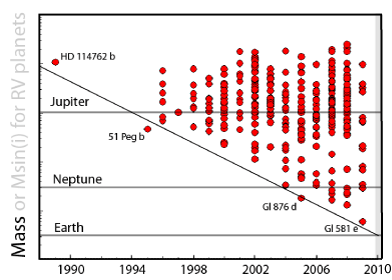…are often risky, but can be illuminating nonetheless.
The astronomy decadal report, which was issued a few weeks ago, set forth three big-picture goals for the next decade: (1) searching for the first stars, galaxies, and black holes; (2) seeking nearby habitable planets; and (3) advancing understanding of the fundamental physics of the universe.
It’s looking quite likely that goal number two will be the first to get substantially met. For quite a while now, a plot of year of discovery vs. the known planetary Msin(i)’s has provided grist for speculation that the first announcement of an Earthlike Msin(i) will occur this year…
In all likelihood, the surface of the first Earth-mass object detected in orbit around a sun-like star will be better suited to oven-cleaning than life as we know it. An interesting question, then, is: when will the first potentially habitable planet be detected? As readers know, such a world will very likely be detected via either transit (MEarth, Warm Spitzer or Kepler) or by the radial velocity technique (HD 40307, Alpha Cen B, etc. etc.).
Earlier this year, I struck up an e-mail conversation with Sam Arbesman, a Research Fellow at Harvard who studies computational approaches to the social sciences. Sam has a rather eclectic spectrum of interests, and writes pieces for the Boston Globe and the New York Times on topics ranging from mesofacts to baseball statistics. He’s also in charge of collecting fares for the Milky Way Transit Authority.
We carried out a scientometric analysis to arrive at what we believe is likely to be a reasonably accurate prediction of the discovery date of the first potentially habitable extrasolar planet with a mass similar to Earth.
Our paper has been accepted by the journal PLoS One, and Sam just posted to arXiv, apparently with little time to spare. The best-guess date that emerged from the analysis is May 2011.
Audaciously, alarmingly close! Certainly soon enough, in any case, for us to look rather sheepish if we’re off by a significant amount…



Pingback: » When Will the First Earth-like Planet Be Discovered? arbesman.net
Pingback: Tweets that mention systemic » Extrapolations… -- Topsy.com
Why not just make this a lottery? My personal vote is for, 10 August, 2010, and the Kepler folks just haven’t had time to weed out the cases for it (them) being a false positive yet. Interesting paper, hope I can be forgiven for not taking it too seriously though.
Oh boy! I wish you guys could wait for me to get my Phd, so I can be involved in this discovery. Prof. Laughlin, no chance they can push this date to my post doc years, is there?? LOL
Pingback: Mai 2011: Entdeckung des ersten erdähnlichen Planeten
Pingback: Twitted by ahenotri
And now… Gliese 581 g. That was fast.
What is the price on ‘g?
hmmm, perhaps I was a bit pessimistic. Though it does appear that Gleise 581 g was discovered before my guess, it’s not clear how MUCH earlier. As long as the planet doesn’t disappear however, I think I win! (though not for the reason I guessed).
“g” comes out with 0.4 on the scale in the Arbesman paper (due to its relatively substantial Msin(i)). It has a value of ~33K on the habitable planet valuation formula that I’ve pushed in previous posts. That’s considerably higher than the previous best, which was 581c, with a valuation of $160.
Well it seems that Gliese 581g is somewhat less secure than could be desired. I’ve used the console on the published RVs and I’m not convinced either.